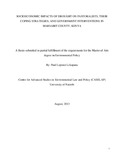| dc.description.abstract | This study investigated the socioeconomic effects of drought on pastoralists, their coping and
adaptation strategies, and the government interventions in Loiyangalani Division of Marsabit
County. Using both qualitative and quantitative approaches, the study employed desktop review
of relevant documents, semi-structured questionnaires, and interview schedules on key
informants and focus groups. Multi-stage sampling method was used on households. To
corroborate drought perceptions, rainfall data between 1970 and 2008 were analysed for trend
and anomaly. Qualitative data were coded and subjected to thematic analysis, whereas,
quantitative data were subjected to descriptive statistics.
Rainfall data shows a declining trend in precipitation between 1970 and 2008. Pastoralists in
Loiyangalani perceived drought as lack of rainfall for one or more seasons and classified it as
minor or major. Livestock mortalities and morbidity, human morbidity, conflicts, food
insecurity, reduction of livestock prices, and increase in food prices were among the
socioeconomic impacts of drought experienced. The coping and adaptation mechanisms
employed by the pastoralists included mobility, herd diversification, herd splitting/merging, sale
of livestock, and livelihood diversification amongst others. The study revealed that government
intervention has been largely through provision of emergency food aid. The government has put
in place policy and institutional framework to address the issue of drought. However, insufficient
financing and low prioritization has hampered effective implementation of these policies. The
study recommends a policy strategy geared towards diversification of pastoral livelihoods and
promotion of their resilience. This includes establishment of road infrastructure, improvement of
livestock marketing and trade, provision of veterinary services, development of water resources
and provision of public health facilities. | en |

